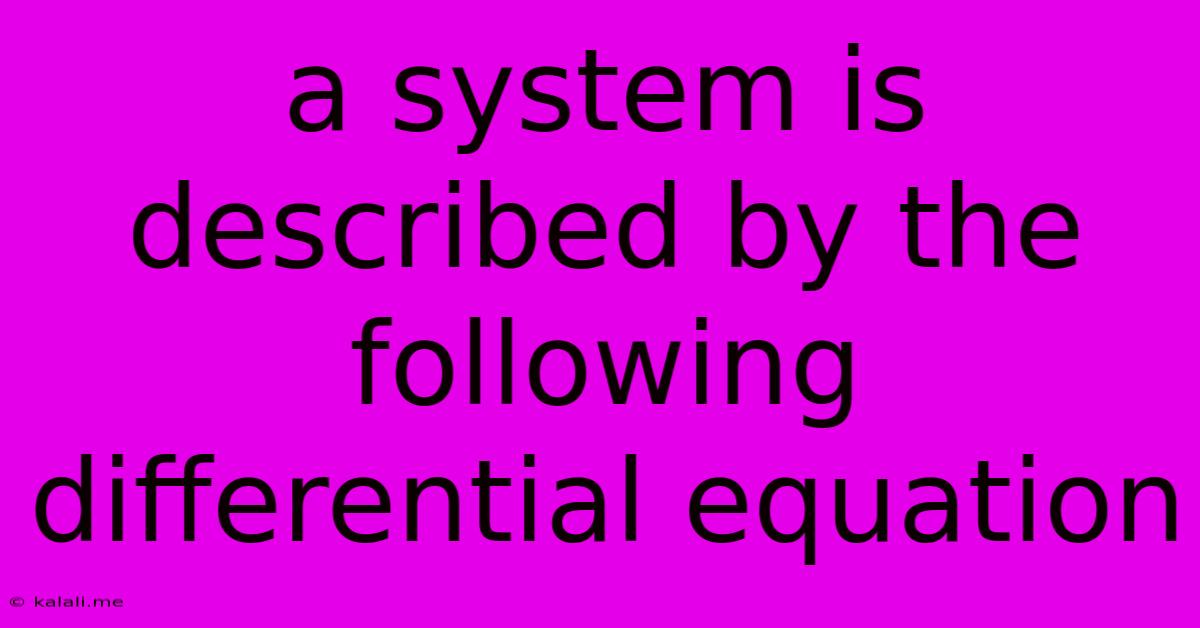A System Is Described By The Following Differential Equation
Kalali
Jun 13, 2025 · 3 min read

Table of Contents
Understanding and Solving the Differential Equation: A Comprehensive Guide
This article delves into the analysis and solution of a differential equation, a fundamental concept in various fields like physics, engineering, and economics. While a specific differential equation isn't provided in the prompt, we'll explore the general process of understanding and solving such equations, covering various types and methods. This guide will equip you with the knowledge to tackle a wide range of differential equations, regardless of their specific form. Understanding differential equations is crucial for modeling dynamic systems and predicting their behavior over time.
What is a Differential Equation?
A differential equation is an equation that relates a function with its derivatives. In simpler terms, it describes how a quantity changes over time or in response to other variables. These equations are powerful tools for modeling real-world phenomena, from the motion of a pendulum to the growth of a population. The order of a differential equation is determined by the highest order derivative present. For instance, a first-order differential equation involves only the first derivative, while a second-order equation involves the second derivative and possibly lower-order derivatives.
Types of Differential Equations
Differential equations are categorized into several types based on their properties:
-
Ordinary Differential Equations (ODEs): These equations involve functions of a single independent variable and their derivatives. For example,
dy/dx = x² + yis an ODE. -
Partial Differential Equations (PDEs): PDEs involve functions of multiple independent variables and their partial derivatives. These are commonly used in modeling complex systems with spatial and temporal variations. The heat equation and the wave equation are classic examples.
-
Linear Differential Equations: These equations have the property that the dependent variable and its derivatives appear only to the first power and are not multiplied together.
-
Nonlinear Differential Equations: Equations that do not satisfy the linearity condition are classified as nonlinear. Nonlinear equations are often much more challenging to solve analytically.
-
Homogeneous Differential Equations: A homogeneous ODE is one where setting the dependent variable and all its derivatives to zero results in the equation being satisfied.
Methods for Solving Differential Equations
The method used to solve a differential equation depends on its type and order. Some common techniques include:
-
Separation of Variables: This method is applicable to certain first-order ODEs where the variables can be separated on opposite sides of the equation, allowing for direct integration.
-
Integrating Factors: This technique is useful for solving first-order linear ODEs. An integrating factor is multiplied to the equation to make it integrable.
-
Variation of Parameters: This method can be used to solve second-order linear ODEs, particularly those with non-homogeneous terms.
-
Laplace Transforms: This powerful method transforms a differential equation into an algebraic equation, which is often easier to solve. The solution is then transformed back to the time domain.
-
Numerical Methods: For complex or nonlinear equations that lack analytical solutions, numerical methods such as Euler's method or Runge-Kutta methods are employed to obtain approximate solutions.
Applying Differential Equations: A Real-World Example
Consider modeling population growth. A simple model uses a first-order ODE: dP/dt = kP, where P is the population, t is time, and k is the growth rate. This equation states that the rate of population change is proportional to the current population. Solving this equation using separation of variables yields an exponential growth model.
Conclusion
Differential equations are fundamental tools for modeling dynamic systems and phenomena. Understanding their different types and employing appropriate solution techniques is crucial in various scientific and engineering disciplines. While the specific solution to a given differential equation depends heavily on its form, the principles outlined in this article provide a solid foundation for approaching a wide range of problems. Remember that practice is key to mastering the art of solving differential equations.
Latest Posts
Latest Posts
-
How Fast Does A Peacock Run
Jun 14, 2025
-
Which Of These Lines Is A Metaphor
Jun 14, 2025
-
Difference Between Quality Control And Quality Assurance Pdf
Jun 14, 2025
-
Gpa Requirements For University Of Memphis
Jun 14, 2025
-
What Are The Prime Factors Of 156
Jun 14, 2025
Related Post
Thank you for visiting our website which covers about A System Is Described By The Following Differential Equation . We hope the information provided has been useful to you. Feel free to contact us if you have any questions or need further assistance. See you next time and don't miss to bookmark.